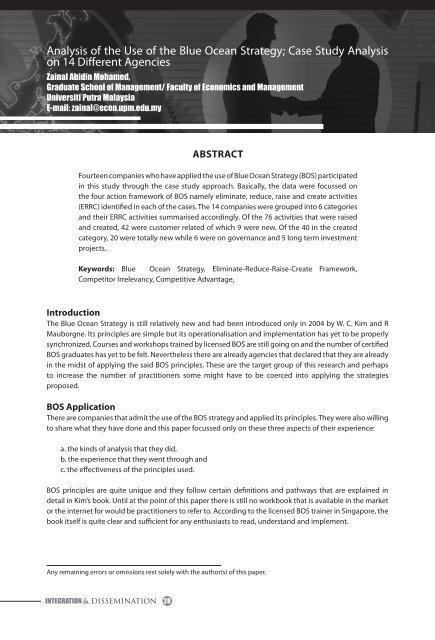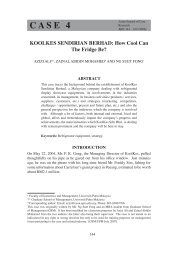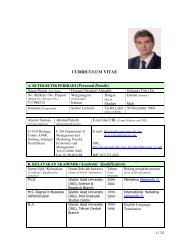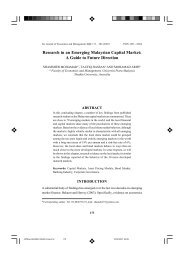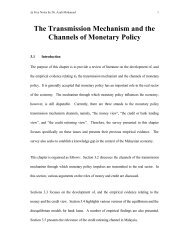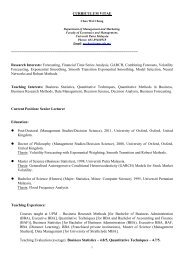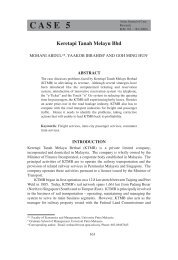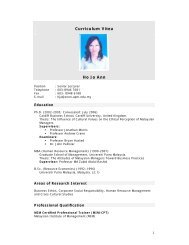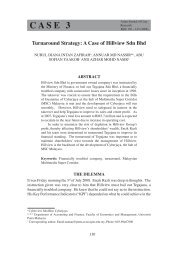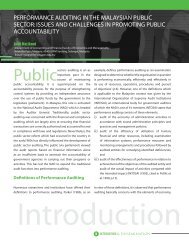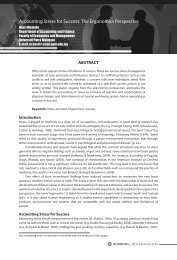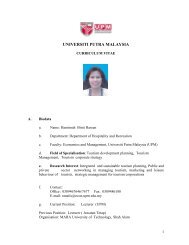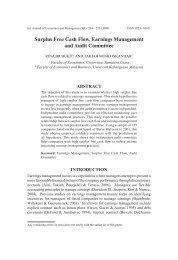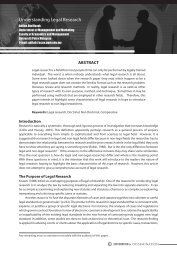Analysis of the Use of the Blue Ocean Strategy - Universiti Putra ...
Analysis of the Use of the Blue Ocean Strategy - Universiti Putra ...
Analysis of the Use of the Blue Ocean Strategy - Universiti Putra ...
You also want an ePaper? Increase the reach of your titles
YUMPU automatically turns print PDFs into web optimized ePapers that Google loves.
<strong>Analysis</strong> <strong>of</strong> <strong>the</strong> <strong>Use</strong> <strong>of</strong> <strong>the</strong> <strong>Blue</strong> <strong>Ocean</strong> <strong>Strategy</strong>; Case Study <strong>Analysis</strong><br />
on 14 Different Agencies<br />
Zainal Abidin Mohamed,<br />
Graduate School <strong>of</strong> Management/ Faculty <strong>of</strong> Economics and Management<br />
<strong>Universiti</strong> <strong>Putra</strong> Malaysia<br />
E-mail: zainal@econ.upm.edu.my<br />
Abstract<br />
Fourteen companies who have applied <strong>the</strong> use <strong>of</strong> <strong>Blue</strong> <strong>Ocean</strong> <strong>Strategy</strong> (BOS) participated<br />
in this study through <strong>the</strong> case study approach. Basically, <strong>the</strong> data were focussed on<br />
<strong>the</strong> four action framework <strong>of</strong> BOS namely eliminate, reduce, raise and create activities<br />
(ERRC) identified in each <strong>of</strong> <strong>the</strong> cases. The 14 companies were grouped into 6 categories<br />
and <strong>the</strong>ir ERRC activities summarised accordingly. Of <strong>the</strong> 76 activities that were raised<br />
and created, 42 were customer related <strong>of</strong> which 9 were new. Of <strong>the</strong> 40 in <strong>the</strong> created<br />
category, 20 were totally new while 6 were on governance and 5 long term investment<br />
projects.<br />
Keywords: <strong>Blue</strong> <strong>Ocean</strong> <strong>Strategy</strong>, Eliminate-Reduce-Raise-Create Framework,<br />
Competitor Irrelevancy, Competitive Advantage,<br />
Introduction<br />
The <strong>Blue</strong> <strong>Ocean</strong> <strong>Strategy</strong> is still relatively new and had been introduced only in 2004 by W. C. Kim and R<br />
Mauborgne. Its principles are simple but its operationalisation and implementation has yet to be properly<br />
synchronized. Courses and workshops trained by licensed BOS are still going on and <strong>the</strong> number <strong>of</strong> certified<br />
BOS graduates has yet to be felt. Never<strong>the</strong>less <strong>the</strong>re are already agencies that declared that <strong>the</strong>y are already<br />
in <strong>the</strong> midst <strong>of</strong> applying <strong>the</strong> said BOS principles. These are <strong>the</strong> target group <strong>of</strong> this research and perhaps<br />
to increase <strong>the</strong> number <strong>of</strong> practitioners some might have to be coerced into applying <strong>the</strong> strategies<br />
proposed.<br />
BOS Application<br />
There are companies that admit <strong>the</strong> use <strong>of</strong> <strong>the</strong> BOS strategy and applied its principles. They were also willing<br />
to share what <strong>the</strong>y have done and this paper focussed only on <strong>the</strong>se three aspects <strong>of</strong> <strong>the</strong>ir experience:<br />
a. <strong>the</strong> kinds <strong>of</strong> analysis that <strong>the</strong>y did,<br />
b. <strong>the</strong> experience that <strong>the</strong>y went through and<br />
c. <strong>the</strong> effectiveness <strong>of</strong> <strong>the</strong> principles used.<br />
BOS principles are quite unique and <strong>the</strong>y follow certain definitions and pathways that are explained in<br />
detail in Kim’s book. Until at <strong>the</strong> point <strong>of</strong> this paper <strong>the</strong>re is still no workbook that is available in <strong>the</strong> market<br />
or <strong>the</strong> internet for would be practitioners to refer to. According to <strong>the</strong> licensed BOS trainer in Singapore, <strong>the</strong><br />
book itself is quite clear and sufficient for any enthusiasts to read, understand and implement.<br />
Any remaining errors or omissions rest solely with <strong>the</strong> author(s) <strong>of</strong> this paper.<br />
INTEGRATION & DISSEMINATION 28
Literature Review<br />
Since this is more on applied research and probably <strong>the</strong> first <strong>of</strong> its kind in trying to look at <strong>the</strong> operationalisation<br />
<strong>of</strong> BOS, literature on its application has yet to be documented in <strong>the</strong> journals. Never<strong>the</strong>less a brief<br />
explanation as to what BOS is all about might be in order. As in most o<strong>the</strong>r strategic models, <strong>the</strong> ultimate<br />
aim <strong>of</strong> strategising is that by <strong>the</strong> action, <strong>the</strong> company would be at an advantage over <strong>the</strong> competitors.<br />
Thus <strong>the</strong> two general models such as <strong>the</strong> Strength-Weaknesses-Opportunities and Threats (SWOT), and<br />
Strategic Positioning and Action Evaluation (SPACE) are done differently than <strong>the</strong> portfolio models <strong>of</strong><br />
Boston Consulting Group (BCG) and SHELL/GE. But <strong>the</strong>y all generate strategies for <strong>the</strong> agencies. And what is<br />
common to all, are that <strong>the</strong>y utilise and consider two sets <strong>of</strong> variables, namely <strong>the</strong> external and <strong>the</strong> internal<br />
variables before <strong>the</strong> various strategic choices are generated.<br />
The SWOT model will have a set <strong>of</strong> external variables (list <strong>of</strong> opportunities and threats) being paired<br />
with <strong>the</strong> internal variables (list <strong>of</strong> strengths and weaknesses) and from which alternative strategies are<br />
generated (David 2006). Similarly <strong>the</strong> SPACE model would pair two sets <strong>of</strong> internal variables (average<br />
score <strong>of</strong> Financial Strengths and Competitive Advantage) with <strong>the</strong> external variables (average score for <strong>the</strong><br />
Industrial Attractiveness and Environmental Stability) and <strong>the</strong> average <strong>of</strong> all <strong>the</strong> four dimensions would give<br />
an idea <strong>of</strong> what strategic choices would best fit <strong>the</strong> agency concern (Mintzberg 2003 ).<br />
Then <strong>the</strong>re are <strong>the</strong> portfolio models (BCG, Shell, GE) where various portfolios could be viewed in one<br />
chart and strategies would depend on <strong>the</strong> portfolios in <strong>the</strong>ir respective quadrants (Star, Cash Cow, Dog and<br />
Question Mark quadrant). Here only one external and one internal factor are chosen. BCG chose relative<br />
market share and <strong>the</strong> industrial growth rate as <strong>the</strong>ir dimensional variables (Grant 2005). Of course in its<br />
application in different scenarios o<strong>the</strong>r variables could be used (especially for non-pr<strong>of</strong>it organisation,<br />
Drucker 1990).<br />
But in all <strong>the</strong> models prior to BOS, <strong>the</strong> variables used have always been <strong>the</strong> pairings <strong>of</strong> external and<br />
internal factors.<br />
But when BOS model was documented, it is <strong>the</strong> first time that direct pairing <strong>of</strong> external and internal<br />
variables was not done. In its graph (authors call it <strong>the</strong> strategic canvas), <strong>the</strong> x-axis are made up <strong>of</strong> <strong>the</strong><br />
industry’s significant factors <strong>of</strong> competition (and are discrete in nature) whilst <strong>the</strong> y-axis are its relative<br />
performance scores or values as perceived by <strong>the</strong> customers. As shown in <strong>the</strong> graph, it is always a comparison<br />
between <strong>the</strong> company’s relative score against o<strong>the</strong>r players in <strong>the</strong> same industry on every <strong>of</strong> <strong>the</strong> discrete<br />
factors considered.<br />
Anyway <strong>the</strong>re are o<strong>the</strong>r BOS principles and framework that can be researched into such as:<br />
a. The six principles proposed namely:<br />
i. Reconstruct market boundaries,<br />
ii. Focus on <strong>the</strong> big picture,<br />
iii. Reach beyond existing demand,<br />
iv. Get <strong>the</strong> strategic sequence right,<br />
v. Overcome organizational hurdles,<br />
vi. Build execution into strategy.<br />
b. BOS Framework and Tools which include:<br />
i. <strong>Strategy</strong> Canvas: diagnostic & action framework<br />
ii. Four Actions Framework: value innovation analysis<br />
iii. Eliminate-Reduce-Raise-Create Grid<br />
iv. Six Paths Framework: market reconstruction analysis<br />
v. Four Steps Visual Strategies: big picture analysis<br />
vi. 3-Tier Of Non customers: demand expansion framework<br />
vii. BOS sequences<br />
viii. Buyer Utility Map<br />
29<br />
INTEGRATION & DISSEMINATION
ix. Buyer Experience Cycle<br />
x. Price Corridor <strong>of</strong> <strong>the</strong> Mass<br />
xi. BOS Pr<strong>of</strong>it Model<br />
xii. <strong>Blue</strong> <strong>Ocean</strong> Idea Index<br />
This paper will only look at <strong>the</strong> main output <strong>of</strong> <strong>the</strong> model; that <strong>of</strong> <strong>the</strong> ERRC Grid. It will be an exploratory<br />
research as <strong>the</strong>re is limited experience or research documentation on <strong>the</strong> subject. When <strong>the</strong>re is a need to<br />
discover new ideas, <strong>the</strong> real application <strong>of</strong> BOS has not been diagnosed yet and <strong>the</strong>re need to be some kind<br />
<strong>of</strong> concept testing and screening process, <strong>the</strong>n exploratory research would fit well in such a scenario. Case<br />
study method would <strong>the</strong>n assist <strong>the</strong> understanding as it is confined to within a specific boundary i.e. that<br />
<strong>of</strong> <strong>the</strong> agency (Zikmund 2003).<br />
Methodology:<br />
This is a case study approach as well as an exploratory analysis <strong>of</strong> 14 companies who agreed to participate<br />
by sharing <strong>the</strong> BOS principles that <strong>the</strong>y have used and applied in <strong>the</strong>ir respective agencies. On record this<br />
is a first research <strong>of</strong> its kind.<br />
Those that claimed that <strong>the</strong>y have applied BOS principles were sought to participate in this study. Six<br />
companies/agencies (group A) were detected and agreed to participate (out <strong>of</strong> 23 who claimed that <strong>the</strong>y are<br />
already applying <strong>the</strong> BOS principles) while ano<strong>the</strong>r 20 wanted to participate (group B) if discussion on what<br />
BOS is all about can be organized. These 26 were <strong>the</strong>n scheduled for a meeting and a half day workshop<br />
organized to get <strong>the</strong>m understand and have a common understanding <strong>of</strong> what BOS is all about. Group A<br />
shared <strong>the</strong>ir understanding as well as <strong>the</strong> experiences. To let all <strong>of</strong> <strong>the</strong>m have a common understanding,<br />
<strong>the</strong> BOS principles were simplified and a follow up was made to schedule individual company visit. Some<br />
labelled this as “action research” methodology. To date only 16 companies have <strong>the</strong>ir experience and data<br />
made available for <strong>the</strong> research (<strong>of</strong> which 14 are used in <strong>the</strong> analysis) but with a promise that <strong>the</strong>ir names<br />
and <strong>the</strong>ir respective strategies not revealed.<br />
Data Ga<strong>the</strong>red<br />
For those who want to know more about BOS’s principles, please refer to <strong>the</strong> appropriate refrerences. As far<br />
as this paper is concern, only <strong>the</strong> utility principles are being analysed. This is detailed out as <strong>the</strong> ERRC Grid<br />
and <strong>the</strong>y are namely:<br />
a. <strong>the</strong> utilities that are being eliminated,<br />
b. reduced,<br />
c. raised and<br />
d. created.<br />
All <strong>the</strong> ERRC tables <strong>of</strong> <strong>the</strong> 14 companies were ga<strong>the</strong>red and a qualitative analysis <strong>the</strong>n applied to understand<br />
<strong>the</strong> characteristics <strong>of</strong> <strong>the</strong>se variables. (See Table 1)<br />
Data <strong>Analysis</strong><br />
At this point in time <strong>the</strong> s<strong>of</strong>tware “ethnograph 5.07 version” is not applicable yet as <strong>the</strong> number <strong>of</strong> companies<br />
participating is still too small. Thus a manual analysis was done from <strong>the</strong> raw data.<br />
The agencies were arranged according to some pattern and in this list, <strong>the</strong> academic agencies were<br />
listed first , followed by one government, three GLCs and <strong>the</strong> rest were private companies. The ERCC content<br />
were <strong>the</strong>n listed out and some commonalities were attempted to derive some pattern. As <strong>the</strong> number <strong>of</strong><br />
cases were small, <strong>the</strong> “Elimination” and “Reduce” utilities and <strong>the</strong> “Raise” and “Create” components were<br />
grouped toge<strong>the</strong>r to get a bigger mass. (See Table 1)<br />
INTEGRATION & DISSEMINATION 30
Table 1: ERCC Grid summary <strong>of</strong> <strong>the</strong> 14 agencies<br />
Firm grouping Eliminate Reduce Raise Create<br />
1 Programmes(6) operating costs (9) Quality (8) customer<br />
satisfaction (4)<br />
2 product variations (6) Tangibles (10) Improving customer<br />
service (12)<br />
10 new activities<br />
3 costly<br />
activities (3)<br />
overheads and<br />
indirect (9)<br />
more customer<br />
satisfaction (12)<br />
closer to customers<br />
(5)<br />
4 internal processes (3) new activities (4) Governance (6)<br />
5 operational activities<br />
(4)<br />
reduce time taken (3)<br />
long duration<br />
effects (10)<br />
6 Investments (5)<br />
Findings<br />
The qualitative analysis indicate that while <strong>the</strong> agencies involved (only 14) were quite diversified, <strong>the</strong>ir<br />
strategic actions with regard to <strong>the</strong> ERRC Grid components do show some commonalities as indicated by<br />
<strong>the</strong> following chart.<br />
Chart 1 shows that for <strong>the</strong> agencies to “eliminate” or “reduce” some <strong>of</strong> <strong>the</strong> utilities as seen through<br />
<strong>the</strong> eyes <strong>of</strong> <strong>the</strong> customers, costs components seem to be <strong>the</strong> main focus followed by activities that are<br />
not giving good returns. This could be seen in <strong>the</strong> form <strong>of</strong> programmes for <strong>the</strong> academic institutions and<br />
product diversity and variations for <strong>the</strong> private companies.<br />
Chart 2 on <strong>the</strong> o<strong>the</strong>r hand seems to be heavy on <strong>the</strong> customer satisfaction scores as well as providing<br />
new products or services to <strong>the</strong> customers.<br />
These activities are specific to <strong>the</strong> case or agency concerned and generalisation can only be made<br />
up to this point. Any fur<strong>the</strong>r generalisation attempts might not be fair considering <strong>the</strong> number <strong>of</strong> cases<br />
analysed.<br />
31<br />
INTEGRATION & DISSEMINATION
educe time<br />
taken<br />
internal<br />
process<br />
costly<br />
activities<br />
operational<br />
activities<br />
product<br />
variations<br />
programmes<br />
overheads<br />
and indirect<br />
cost<br />
operating<br />
costs<br />
tangibles<br />
Chart 1: Eliminate and Reduce Grid <strong>of</strong> 14 Agencies<br />
INTEGRATION & DISSEMINATION 32
Chart 2: Raise and Create Grid <strong>of</strong> 14 Agencies<br />
33<br />
INTEGRATION & DISSEMINATION
Conclusion<br />
The exploratory analysis was an attempt to understand deeper <strong>the</strong> practise <strong>of</strong> BOS principles. As <strong>the</strong> BOS<br />
framework do go into details on how <strong>the</strong>y are to be implemented, <strong>the</strong> data that were shared were confined<br />
only to <strong>the</strong> ERRC Grid component. It has to be assumed that <strong>the</strong>y all practised and implement with full<br />
understanding <strong>of</strong> <strong>the</strong> principles as proposed by BOS. But it was noted that nobody in <strong>the</strong> study has got<br />
any recognised BOS certified recognition. Therefore <strong>the</strong>ir level <strong>of</strong> understanding need to be verified. In<br />
fact during <strong>the</strong> discussion <strong>the</strong>re were difference in <strong>the</strong> understanding <strong>of</strong> <strong>the</strong> principles as all had gain <strong>the</strong><br />
knowledge through reading <strong>of</strong> Kim’s book.<br />
The analysis is still on-going with 11 more agencies in <strong>the</strong> pipeline. But as mentioned <strong>the</strong>se data<br />
collection are all through “action research” mode, it is time consuming and each agency need to be<br />
approached differently as <strong>the</strong>y are all different and thus <strong>the</strong> case study methodology.<br />
Acknowledgement:<br />
Thousand appreciation to <strong>the</strong> following agencies that participated: Fibrecom, Proton, MS Elevator, Taylor<br />
college, TM subsidiary, Telekom, International School, O’Connors Engineering, CISB, PTPL, A.G. Off., TNB<br />
subsidiary, 2 local banks, a food processing company.<br />
References:<br />
David F. R. (2006) Strategic Management, Prentice Hall: New York<br />
Drucker Peter F., (1992) Managing <strong>the</strong> Non Pr<strong>of</strong>it Organisation, Harper Business: London<br />
Goldenberg, J. R. Horowitz, A. L. and Marzusky, D. (2003) Finding Your Innovation Sweet Spot, Harvard<br />
Business Review, 81(3): 120-129.<br />
Grant, R. M. (1991) The Resource Based Theory <strong>of</strong> Competitive Advantage ; Implication for <strong>Strategy</strong><br />
Formulation, California Management Review, Spring 33 (3): 114-125<br />
Kaplan, R. S. and Norton, D. P. (2001) The <strong>Strategy</strong> Focused Organization, Harvard Business School Press,<br />
Boston.<br />
Kim, W.C., Mauborgne, R. (2005) <strong>Blue</strong> <strong>Ocean</strong> <strong>Strategy</strong>, Harvard Business School Press: Boston<br />
Lyles, M. A. and Salk, J. E. (2007) Knowledge Acquisition from Foreign Partners in International Joint Venture,<br />
Journal <strong>of</strong> International Business Studies, 38:3-18.<br />
McNamara, G., Deephouse, D. L. and Luce, R. A. (2003) Competitive Positioning within and across Strategic<br />
Group Structure, Strategic Management Journal, 24:161-181.<br />
Mintzberg,H. and Waters, J. (2003) Of Strategies, Deliberate and Emergent, Strategic Management Journal, 6<br />
(2): 257-272<br />
Porter, A. L. and Cunningham, S. W. (2004) Tech Mining; Exploiting New Technologies for Competitive<br />
Advantage, Wiley: Hoboken, NJ<br />
Sanders, T. I., (1998) Strategic Thinking and <strong>the</strong> New Science, Free Press: New York<br />
Santos, J., Doz, Y. and Williamson, P. (2004) Is your Innovation Process Global, MIT Sloan Management<br />
Review, 44(2) 55-63.<br />
Watanabe, K. (2007), Lessons from Toyota Long Drive, Harvard Business Review, 85(7/8); 74-83.<br />
Zainal A. Mohamed (207) Pengurusan Strategik, Utusan Publications: Kuala Lumpur<br />
INTEGRATION & DISSEMINATION 34


